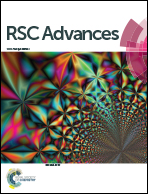Fabrication of robust, damage-tolerant superhydrophobic coatings on naturally micro-grooved wood surfaces†
Abstract
Achieving durable non-wetting surfaces is extremely challenging for hydrophilic bulk materials with intrinsically heterogeneous surface structures, since the coating materials on the surface protrusions could be easily worn out, thereby exposing the underlying hydrophilic bulk materials and leading to loss of non-wettability. Herein, mechanically robust superhydrophobic surfaces were fabricated on naturally micro-grooved wood based on a two-step process, i.e., first applying a primer coating of transparent epoxy resin to cover the surface microstructures, followed by construction of superhydrophobic films using silica/epoxy resin/fluorinated alkylsilane (FAS) nanocomposites. The as-prepared superhydrophobic coatings on wood showed remarkable tolerance against mechanical damages including sandpaper abrasion, finger-wiping and knife-scratching while retaining their superhydrophobicity owing to their roughness-regenerating capability. The coated wood also exhibited excellent durability against water spray impact and ultraviolet (UV) radiation, and more importantly the wood essentially retained its original color and aesthetic appearance despite the coating treatment, highlighting its potential use in various practical applications.


 Please wait while we load your content...
Please wait while we load your content...